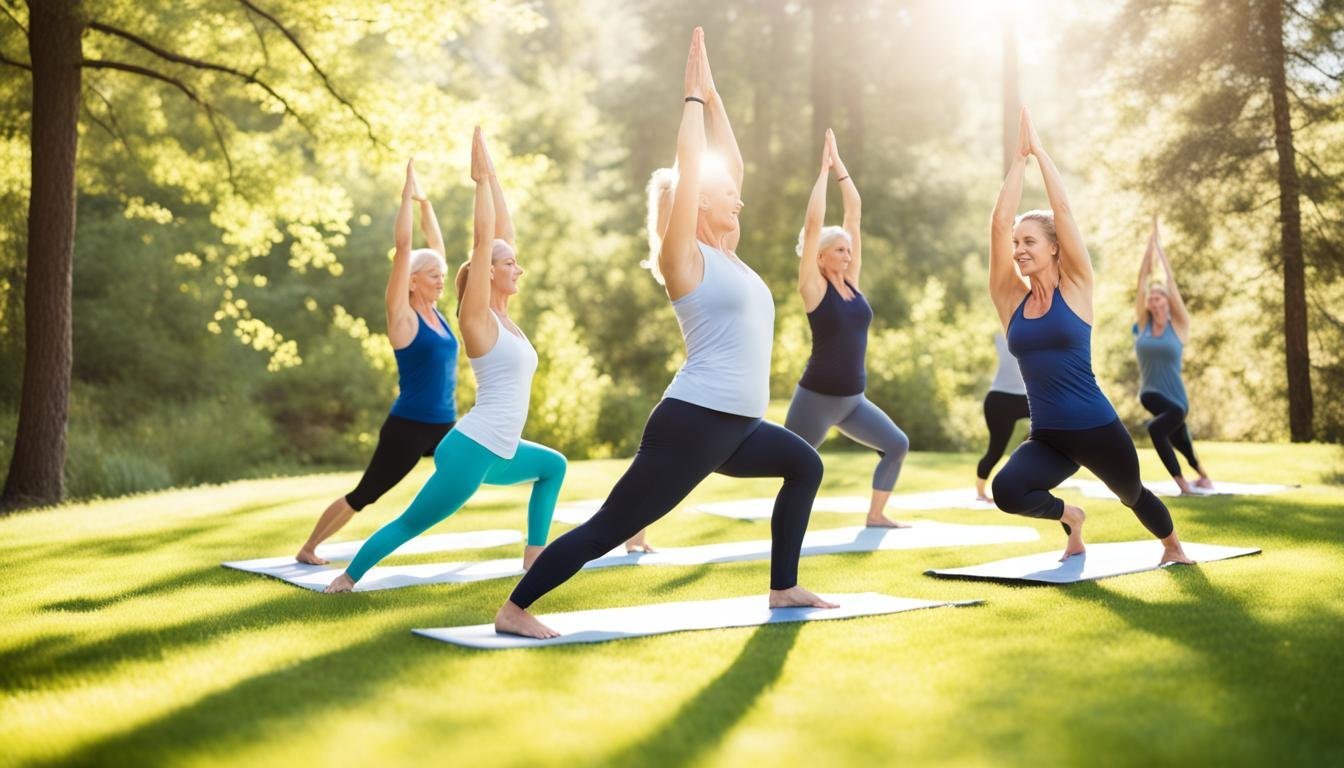Yoga is for everyone, from newbies to experts. It includes meditation, mindfulness, asanas, pranayama, and chakra work.
It’s a full wellness approach for all kinds of people. You might like the flowing vinyasa, the precise hatha, the deep yin stretches, or the calming restorative yoga. There’s a style for you.
Yoga helps with physical fitness, flexibility, strength, and balance. It also helps with stress, focus, and mindfulness.
Key Takeaways:
- Yoga is suitable for individuals of all levels, from beginners to advanced practitioners.
- It combines meditation, mindfulness, asanas, pranayama, and working with the chakras.
- Various yoga styles cater to different preferences and needs.
- Yoga offers physical, mental, and emotional benefits.
- Engaging in yoga practices can contribute to overall well-being and balance.
Understanding Yoga Levels
Yoga classes are divided into levels to match different experience and skills. These levels help people start at the right place and move up as they get stronger and more familiar with basic poses.
Yoga has three main levels: beginner, intermediate, and advanced. Each level has its own set of challenges and chances to grow.
Beginner yoga classes focus on basic poses, how to stand right, and breathing. They’re great for those new to yoga or with little experience. These classes offer a supportive place to learn yoga basics and build strength, balance, and flexibility.
Intermediate yoga classes are for those who know the basics well and want to go deeper. These classes offer more complex and intense poses. Here, you can work on improving how you stand, last longer, and try harder poses.
Advanced yoga classes are for those who have a strong practice and can handle tough poses. These classes move fast and include hard postures. They require a lot of strength, flexibility, and focus.
It’s key to listen to your body and practice mindfully, no matter your level. Yoga is a journey that moves forward with regular practice and kindness to yourself. There’s always more to learn and discover, whether you’re just starting or have been practicing for years.
To understand the main differences between yoga levels, see the table below:
| Level | Description |
|---|---|
| Beginner | Focus on introducing basic poses and alignment principles. Suitable for new practitioners. |
| Intermediate | Increase complexity and intensity of poses. Suitable for those with a good grasp of foundational poses. |
| Advanced | Explore advanced poses and sequences. Suitable for experienced practitioners. |
Knowing about yoga levels and starting at the right one helps you practice safely and enjoyably. It also supports your growth and progress in yoga.
Level 1 Yoga for Beginners
Welcome to the world of yoga! Level 1 yoga classes are perfect for beginners. They help you start your yoga journey or improve if you’re new to it. These classes focus on basic poses, how to stand right, and breathing techniques. They’re great for building strength, flexibility, and mindfulness.
In these classes, you’ll learn many foundational poses. These poses improve your body awareness, balance, and stability. It’s key to know how to stand right in each pose to avoid injury and get the most out of it. Your instructor will show you how to do the poses and adjust them for you. This makes it safe and effective as you get better at yoga.
Level 1 classes also teach you about breathing techniques, or pranayama. Breathing right with your movements is a big part of yoga. It calms your mind and helps energy flow better in your body. This makes your practice deeper and helps you relax.
Level 1 yoga is great for improving flexibility, strength, or reducing stress. It’s a supportive place for beginners to try yoga at their own speed. So, get your mat ready, take a deep breath, and start this journey of self-discovery and well-being.

Benefits of Level 1 Yoga for Beginners:
- Builds a strong foundation for further yoga practice
- Develops body awareness, balance, and stability
- Promotes flexibility and strength
- Reduces stress and promotes relaxation
- Enhances mindfulness and mental clarity
- Boosts overall health and well-being
Sample Level 1 Yoga Sequence:
| Pose | Description |
|---|---|
| Mountain Pose (Tadasana) | Stand tall with feet together, grounding through the feet and lengthening the spine. |
| Tree Pose (Vrikshasana) | Shift weight onto one leg, placing the foot of the opposite leg either above or below the knee. |
| Downward Facing Dog (Adho Mukha Svanasana) | Start on all fours, then lift the hips up and back, straightening the legs and pressing the heels toward the ground. |
| Child’s Pose (Balasana) | Sit back on your heels and fold forward, resting your forehead on the mat and extending your arms forward. |
Remember, yoga is a journey and progress is made over time. Enjoy the process and be kind to yourself. With regular practice and hard work, you’ll see how yoga can change your life.
Intermediate Yoga Practices
If you’ve been practicing yoga for a while and have a solid foundation, you might be ready for intermediate yoga. Intermediate classes help you progress and challenge yourself more. They also help you build strength and flexibility.
Intermediate yoga is all about moving forward. It takes the basic poses you know and adds new twists and deeper expressions. This lets you grow your body’s abilities and reach new heights in physical and mental growth.
In these classes, you’ll find challenging poses that need more strength and flexibility. You might try inversions like headstand and forearm stand, or poses like crow and wheel. These poses help you build strength and improve your body and mind focus.
Remember, intermediate yoga is harder, but progress is slow. Everyone’s journey is different. It’s important to listen to your body and go at a pace that feels right. If a pose is tough at first, don’t worry. With regular practice and patience, you’ll get there.
Intermediate yoga also lets you work on your alignment. With a better understanding of basic poses, you can make small adjustments. This makes your practice more stable and effective. It also helps prevent injuries.
Take your yoga to the next level by adding intermediate poses to your routine. Challenge yourself with harder poses, enjoy the progress, and keep building strength, flexibility, and mindfulness.
| Benefits of Intermediate Yoga | Key Poses | Tips for Progression |
|---|---|---|
|
|
|
Advanced Yoga for Experienced Practitioners
Advanced yoga is for those who have a solid foundation in yoga. They know a lot about flexibility and how their body works. These classes go deeper, with tough poses, complex sequences, and advanced breathing exercises. It’s important to be patient and listen to your body as you try new things.
By now, you’ve learned the basic poses and know your body well. You’re ready to take your yoga to the next level. In these classes, you’ll try poses like arm balances, inversions, and deep backbends. These need strength, flexibility, and balance.
Advanced yoga also focuses on special sequences of poses. These sequences are made to test your body and mind. They mix different poses that flow together smoothly. You’ll do dynamic moves, transitions, and hold poses for a while to deepen your practice.
Advanced classes also introduce new breathing exercises. Pranayama, or breath control, is key in yoga. You’ll learn to breathe in special ways, like Ujjayi breath and Nadi Shodhana. These help balance your body, calm your mind, and connect your breath with your movements.
Advanced yoga is more than just doing cool poses. It’s about understanding yourself better, growing your awareness, and taking care of your whole being. Practitioners often change a lot, both in and out of class.
To get the most from advanced yoga, work with a skilled teacher who can help you. Remember to be humble and listen to your body. It’s important to respect your limits.
Benefits of Advanced Yoga
Advanced yoga has many benefits for those who practice it:
- It makes your body stronger, more flexible, and balanced.
- It helps you focus better, think clearly, and be more mindful.
- You’ll become more aware of yourself and your thoughts.
- It helps you relax more and reduces stress.
- It makes you feel emotionally stable and well.
- It improves your breathing and lung capacity with special breathing exercises.
- It helps you grow spiritually and connect with something bigger.
Advanced yoga is a deep and rewarding journey for those who are serious about yoga. It takes dedication, discipline, and a love for yoga to get the most out of it.
Related Articles
| Title | Description |
|---|---|
| Mastering Advanced Yoga Poses | A comprehensive guide to mastering challenging advanced yoga poses, including step-by-step instructions and tips for safe and effective practice. |
| Sequencing for Advanced Yogis | Learn how to create dynamic and challenging yoga sequences for advanced practitioners, taking their practice to new heights. |
| Exploring Advanced Pranayama Techniques | Dive deep into the world of advanced pranayama techniques and discover their powerful effects on the body, mind, and energy systems. |
Conclusion
Yoga is more than just exercise. It’s a journey that changes us deeply. It helps us find wellness and discover ourselves. By doing meditation, mindfulness, asanas, and pranayama, we can care for our mind, body, and spirit.
There’s a yoga for everyone, from beginners to experts. No matter your level, yoga leads to balance and self-awareness. It lets us dive deep into ourselves, be more mindful, and connect better with our bodies.
Yoga teaches us to live in harmony with ourselves. It brings many benefits, like physical strength, clear thinking, and emotional health. It’s a way to find out who we truly are and live more thoughtfully.
So, start your yoga journey and see how powerful it is. Dive into the practices, accept the changes, and find a balanced, real life. Let yoga lead you to self-discovery, mindfulness, and overall wellness.

